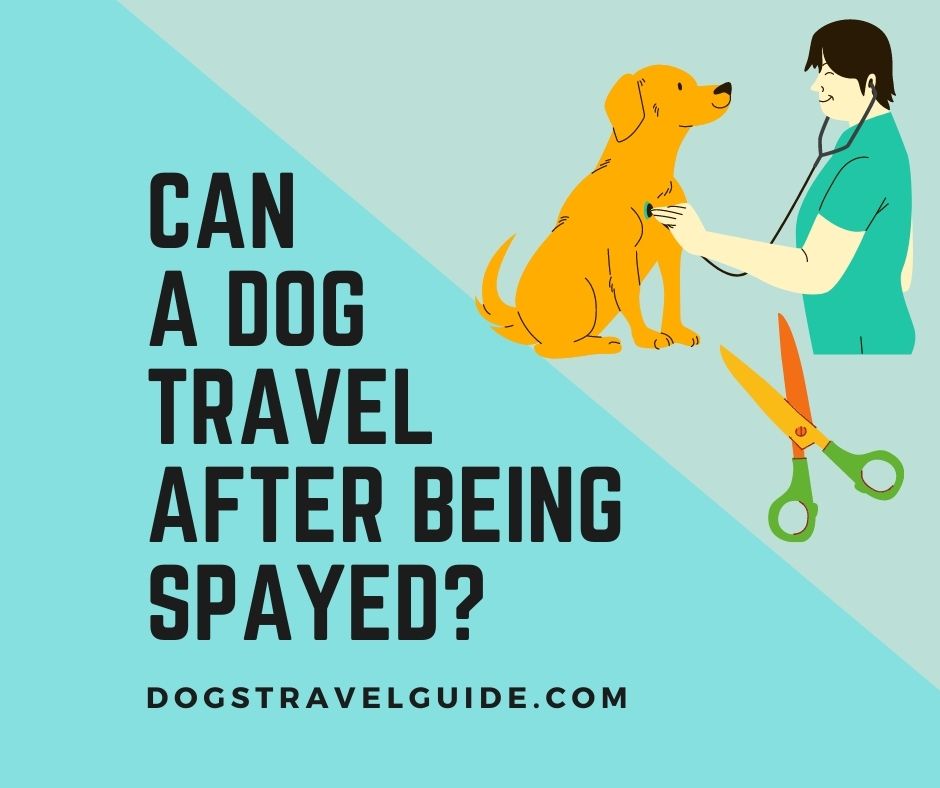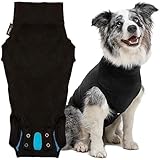Can a dog travel after being spayed? is it safe to travel after a dog’s surgery?
Dog owners often go through confusion about whether the dog can travel after being spayed or not.
Raising a Canine is one big responsibility. A pet parent has to do a lot, from training them on the basics to making them comfortable during socialization.
However, one crucial decision every pet parent goes through is getting their little girly dog Spayed.
Although there is no perfect answer to When and Whether you should Spay your female dog, owners can have their calls.
But if the decision has been made, you must ensure the Spaying care of your Female Dog.
How long after spay can a dog travel?
How soon can a dog travel after being spayed?
Spaying is a surgical procedure that prevents reproduction/ pregnancy in female dogs and cats.
In this procedure, the Vet surgeon removes the ovaries and uterus and sterilizes the dog.
This entire procedure is known as an ovariohysterectomy.
However, lately, several Vet surgeons remove only ovaries (for sterilizing), and the process is known as ovariectomy.
Spaying, though, is a common but major surgery for female dogs.
Some doctors discharge right away, while some advise keeping the dog under medical supervision for a night.
Although the dog can have a light journey after spaying, a long and exhausting journey is discouraged.
A lot of movement and exhaustion can suddenly accumulate fluid under the incision.
It can also cause swelling near the stomach area.
While one can consider light travel after 20 days, train and air travel need a postpone.
Can dogs travel after surgery?
How do I transport my dog after being spayed? Well, that depends on some factors
The success of any surgery depends partially upon the doctor and partially upon the post-operative care.
Even a good spaying treatment can go wrong if you aren’t caring rightly for your dog.
So even before the D-Day of Spaying, make sure you prepare for post-operative care.
- Firstly, prepare a carrier or dog mattress. that is comforatable and non-hypoallegenic for dogs.
- Gently load her (your female dog) into the carrier/ mattress.
- Ensure to clean and sanitize everything you use is to avoid infection in your dog.
- Consider placing the carrier/ mattress at the back seat. If you are using a carrier, make sure you have tucked it well with the seat belt. Or with a mattress, consider making someone sit beside the pet to provide extra stability and comfort.
- Drive slow as even a minor accident (sudden break) can prove fatal for your dog’s stitches.
- Once home, place the spayed dog into a clean and comfortable place. Make sure no other pet comes close to them (not even inside the room).
Can dogs move around after Spaying?
Post spaying surgery, keep your dog as quiet and rested as possible.
Until a week, too much movement can restrict or even delay the healing process.
For the first three days, avoid taking her out, even for walks. Further, after that, consider going for a short on-leash walk.
Make sure the pathway is super clean, and nothing should touch your dog’s stitches.
Dog owners must strictly restrict playing, running, and exhausting spayed dogs for nearly 15 days.
How to comfort a dog after spaying?
Whether it is a human or a dog, everyone needs comfort after going through major surgery.
And when it is about tongue-tied animals, humans must come forward to care.
12 Ways to comfort a dog after spaying
- While it’s just been a day after your dog got spayed, make sure their recovery process goes smooth and easy.
- Let your dog rest in a peaceful and comforting place. Make sure there is no disturbance around or even interference apart from one attendee.
- Further, make your female canine wear an inflatable cone collar. It will prevent them from licking or biting the stitches. Also, make sure to trim their nails and she is not scratching her stitches.
- Keep the stitches and bandage area clean and dry.
- Do not bathe her for 10 to 15 days (until you see the stitches are healing). Avoid any contact of water over the operated region. For regular cleaning after spaying, you can consider a sponge bath. However, because dogs can easily go a month without bathing, you can rest assured.
- Feed her easy-to-digest and un-spiced food. Even if your dog eats slightly spiced food, cut down on all the flavors.
- Even if your dog wants to play, restrict her activities to the most. Do not let your dog move much apart from the bathroom walks. Instead of stepping out, you can make them pee and poop at home only.
- Adjust the room temperature. Excessive heat and humidity can also lead to the decaying of stitches. Thus, maintain the temperature slightly on the cooler side.
- Coughing and heavily barking can cause stress over her stitches; thus, comfort the dog in any such circumstance.
- Encourage your dog to stay calm and relaxed by showing them the same behavior. The dog owner needs to shower care, love and comfort to the dog after her spaying surgery.
- For ensuring your female canine is completely comfortable after the surgery, consider using a dog spay recovery suit.
- Dog spay recovery suit is a professional alternative post pet surgery. The suit is made up of cloth and is designed to protect wounds, sutures, bandages, hotspots, skin problems from any environmental condition.
Depending upon your dog’s body shape and size, you can choose a comfortable dog spay recovery suit for them.
Some great recovery suit options:
Suitical Recovery Suit for Dogs
- The Recovery Suit protects wounds, bandages, hot spots, skin conditions and incontinence in dogs
- The patented alternative to the protective collar and cone offers your pet comfort after surgery
- Lightweight and breathable four-way stretch fabric, acts like a second skin for maximum protection
- Easy to use, with snaps near the base of the tail to allow dogwalking without removal of the shirt
- Extra Small dogs measure the distance from collar to tail: 40 - 45 cm / 15.7 - 17.7"
IDOMIX Recovery Suit for Dogs
- Professional Recovery Suit:Designed for pet recovery,this dog surgery suit female spay effectively prevents...
- Breathable Fabric:This dog recovery suit female is made of 95% cotton and 5% spandex,soft and breathable.The...
- Easy to Wear:The dog surgical recovery suit with unique magic tape and high elasticity makes it easy to put on...
- Multiple Sizes:The dog spay recovery suit female is available in sizes from S to 2XL.L:chest...
- Easy to Clean:Our dog surgery recovery suit can be machine washable, durable and easy to deform, and the dog...
Dog Recovery Suit
- ♣ Effectively help: avoid pets from licking wounds, skin conditions.
- ♣ High-elastic fabric: four-way stretch fabric, hand washable and not easily deformed.
- ♣ Design of a row of buttons: fit the skin better, and some buttons can be unbuttoned to adjust the size of...
- ♣ Substitute E-collar&cone: pets can eat freely and won’t be annoyed.
- ♣ Our style covers most types and pets of all sizes, and the small size is suitable for cats, rabbits,...
Kuoser Recovery Suit for Dogs
- Size Guide: XS (Back:8.3-11.4'', Weight:4-7 LB), S (Back:11.4-13.4'', Weight:7-15 LB), M (Back:13.4-16.1'',...
- Tailored for Pet Recovery: Crafted from high-quality, soft, and breathable fabric, this dog bodysuit is...
- Cone Alternative: Say farewell to the cone of shame! Kuoser dog onesie serves as an excellent alternative,...
- Versatile Usage: Can be used as post-surgery clothing, sterilization attire, weaning outfit, spay/neuter suit....
- Easy to Wear: When your dog needs a bathroom break, remove and secure the tapes with provided instructions,...
Is the Spaying surgery dangerous for your dog?
Spaying is a major though safe surgery. Because it requires cutting and stitching, the vet will inject general anesthesia into the dog.
On a typical note, anesthesia can lead to minor vomiting and diarrhea or decreased appetite in dogs.
In some cases, it can lead to cardiac arrest, stork, and even death in dogs.
However, with medical science growing day by day, these risks have gone lower.
Modern anesthetics and monitoring equipment lower down the risk of any complications.
While the possibility of danger is always live, you can still rest assured while taking your dog for spaying.
Why is my dog not peeing or pooping after Neutering?
It is quite normal for your dog not to pee or poop on the day of surgery.
Even many dogs will not poop for 2 to 3 days after their surgery.
It is because dogs have fasted a day before surgery, and thus their body has no solid and liquid to release.
Why is my dog acting weird after spaying?
Spaying or Neutering leaves both physical and mental changes in dogs. These changes will differ from short to long term.
Just after spaying, your female dog will behave extremely lazy (even after the gone effect of anesthesia).
Though after Neutering, male dogs tend to become more aggressive at times.
Followed with them for the long-term effects- because sex hormone levels diminish after surgery, their body will not develop heat. Dogs will stop hunting formatex as their mating heat no longer exists.
Can my dog sleep in my bed after spaying?
For comfort, it is ideal for letting your dog sleep alone after spaying. You can be by their side, observing them, but avoid making them sleep on the same bed with you.
It is important because you can hurt them unintentionally during sleep. Also, while your dog makes effort to cuddle with you, it can put stress on her stitches.
Sleeping straight is the most comforting position for her for the first few days post-surgery. This will prove less painful instead of roll-up.
Advantages and Disadvantages of Spaying
List of Advantages of Spaying
- It reduces their heating period.
- No ovaries and uterus mean no new pregnancy every another while.
- It reduces the risk of uterus, ovaries and reproductive tract cancer.
- spaying prevents several uterus infections.
- It offers partial protection against breast cancer
List of Disadvantages of Spaying
- Spaying means your dog will possibly gain weight post-recovery. It can double the risk of obesity.
- In some breeds, it can increase the risk of hemangiosarcoma
- It increases the risk of Hypothyroidism.
- Anesthesia can lead to both low-level and high-level risks in dogs.
What is the best time to spay a dog?
The best time to spay a dog is when her reproductive organs are fully developed, but she hasn’t yet experienced her first heat cycle.
As American Animal Hospital Association (AAHA) suggests, take your female canine for spaying when 4 to 6 months old.
We recommend you opt for the process sooner than later.
Wrapping up
From vets to pet experts, everyone recommends that one must take their dog for spaying or neutralizing surgery.
We hope if your dog is due for the same, the above guide will help you with their post-operation recovery.
However, despite any general guidance, consider your vet foremost for some specific questions and advice regarding your pet.





